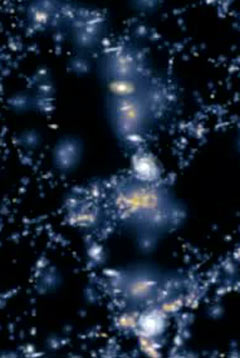
This artist's representation shows how galaxies' disks tend to be oriented perpendicular to the huge filaments of galaxies forming the large-scale cosmic web. In reality, galaxies are much smaller and farther apart, compared to the size of filaments, than shown here. This scene is one frame of a video illustration.
Gabriel Pérez
From the earliest moment of the Big Bang to the universe we see today, just about every step of cosmic evolution has been falling neatly into place in the last few years. Now a group of astronomers is announcing their discovery that another piece of the puzzle fits just right: the ways in which spiral galaxies, such as the Milky Way, tend to be oriented in space.
According to the reigning theory of cosmic structure formation, known as the "cosmological constant plus cold dark matter" (or Lambda-CDM) theory, galaxies grew by the gravitational mergers of smaller clumps of matter that emerged from the Big Bang. These original clumps resulted from the random, submicroscopic quantum fluctuations of particles and energy in the extremely early universe, enormously enlarged by inflation in about the first 10–32 second. The Lambda-CDM theory also explains how galaxies became arranged into huge clusters, filaments, and "great walls" outlining immense voids — the cobwebby cosmic tapestry that we see filling the universe on the largest scales today.
In addition, the theory predicts that the disks of spiral galaxies should tend to be oriented a particular way: with their axes of rotation lying in the plane of the great wall, or in line with the filament, in which the galaxy resides. Several studies have searched for this effect in our own "supergalactic plane," the great wall that contains the Milky Way and the Virgo Galaxy Cluster 50 million light-years away. The results have been very suggestive but not definitive.
Now three European astronomers have found this effect very clearly for the first time. Ignacio Trujillo (University of Nottingham, UK) and Conrado Carretero and Santiago Patiri (Instituto de Astrofisica de Canarias, Spain) sifted through the two largest 3-D surveys of galaxies — the Two-Degree Field Galaxy Redshift Survey (2dFGRS) and the Sloan Digital Sky Survey (SDSS). They identified 201 edge-on or face-on spiral galaxies that clearly lie in walls or filaments that have well-determined 3-D orientations on the perimeters of giant voids at least 50 million light-years across.
Sure enough, the galaxies' disks are perpendicular to the walls and filaments — that is, their axes of rotation lie within these structures — much more often than chance would predict.
This finding, the astronomers note, also meshes with the "Holmberg Effect," first noticed by the Swedish astronomer Erik Holmberg in 1969: the tendency of satellite galaxies not to orbit in the plane of a spiral galaxy host. This pattern too emerges from the Lambda-CDM galaxy-assemblage model. The researchers' report appears in the April 1st Astrophysical Journal Letters.
This same process strikes very close to home. It explains why the Milky Way is oriented the way it is, encircling the sky from Sagittarius through Cassiopeia with its north galactic pole pointing toward Coma Berenices. On a good celestial atlas (such as the Sky Atlas 2000.0 deluxe edition, which shows galaxies in red), bright galaxies form an obvious band across the Northern Hemisphere's spring sky from Ursa Major to Centaurus. This is the supergalactic plane, the local great wall, as seen from our viewpoint inside it. It passes right across Coma Berenices.
Moreover, within this plane, the Milky Way lies inside a denser filament of galaxies that extends straight from us to the Virgo Cluster and far beyond (Sky & Telescope, January 2001 issue, page 22). The Virgo Cluster lies on the border of Virgo and Coma Berenices, very close to where our the axis of our galaxy points.
 0
0
Comments
You must be logged in to post a comment.